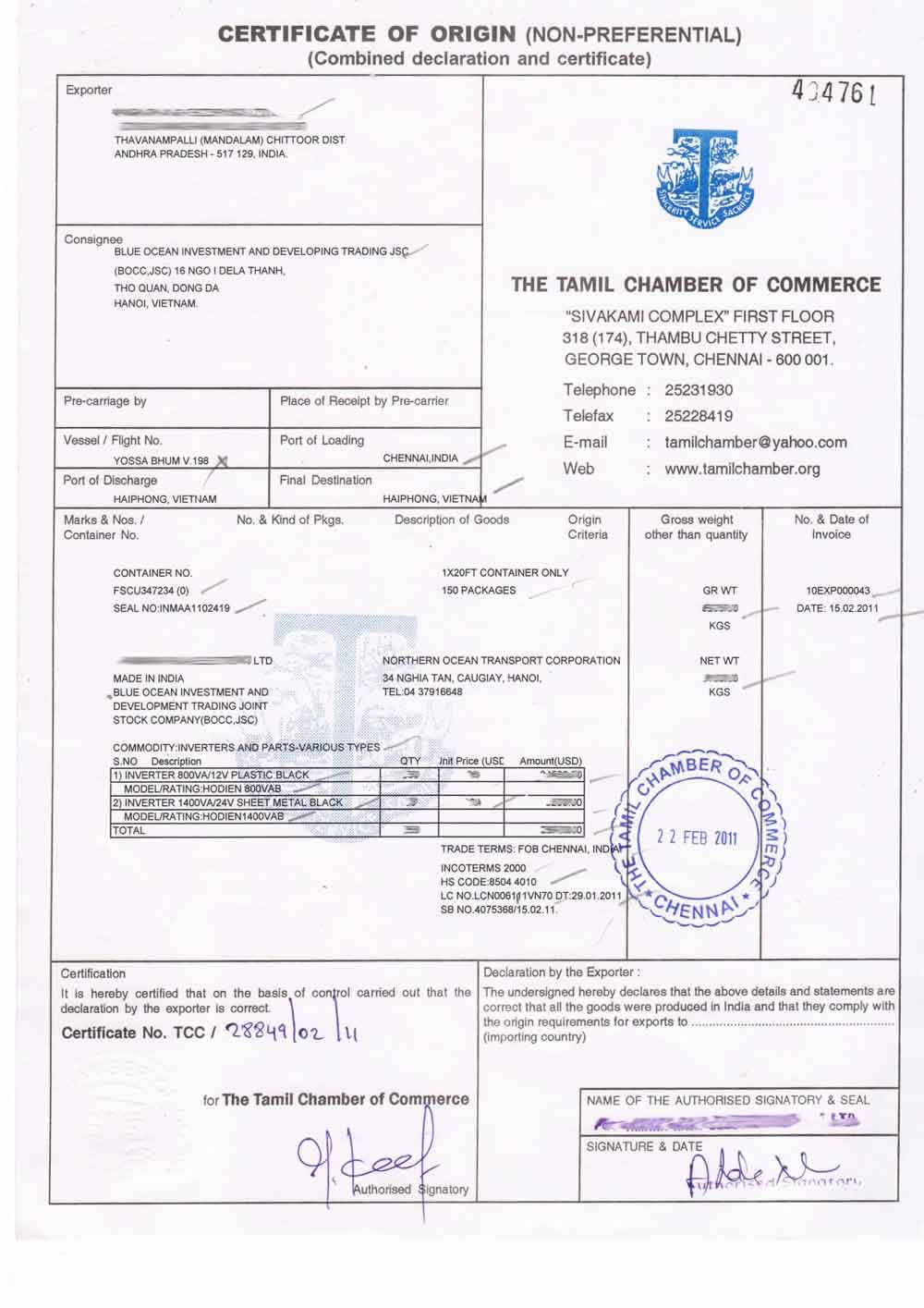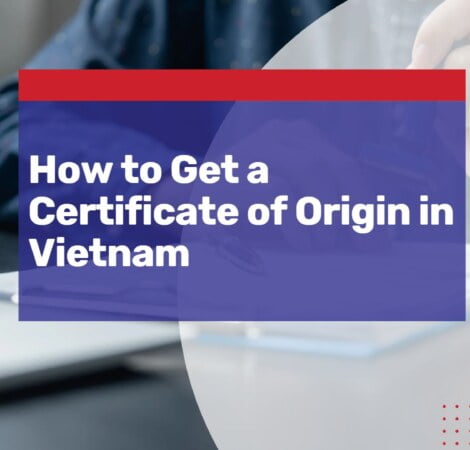A certificate of origin is essential when conducting business in Vietnam since it is the foundation for imposing taxes and other trade restrictions. The certificate specifies the manufacturing or production location of the items in question. And armed with such knowledge, traders are obligated to adhere to all laws, administrative regulations, and trade agreements based on the country of origin of the goods.
Importing or Exporting from Vietnam? Find out About Cekindo’s Product Registration Services.
According to FTAs negotiated between Vietnam and other nations, a notarized certificate of origin in Vietnam may drastically lower product duties or taxes, enabling importers to take advantage of specific tax advantages or other preferential treatments. However, a valid certificate of origin issued in Vietnam may be used to prevent international imports from certain restricted nations.
A certificate of origin is typically required. However, the commercial or sales invoice already includes the origin country details. The Ministry of Industry and Trade of Vietnam or the Chamber of Industry and Commerce can provide foreign investors or companies in Vietnam with the certificate of origin; The certificate is also available from other recognized institutions or organizations.

Procedure for Applying for a Certificate of Origin in Vietnam
All business owners must take the actions listed below to get a certificate of origin:
1. Before applying, go through this checklist:
- Determine the origin of goods and their applicable regulations
- Understand the item’s HS (Harmonized System) code
- Analyze the free trade agreement that was struck with the country that is importing and any associated taxes
- To select the best tax incentive format, compare tax rates
- Verify whether products comply with the nation of origin’s legislation by asking if they are permitted there.
2. If you are a trader requesting the certificate of origin for the first time, submit the necessary business documentation:
If you are a trader making a first-time application for a Certificate of Origin, you must:
Step 1: Register the trader’s profile with the organization or agency issuing the Certificate of Origin. The trader’s shape must be legitimate and complete for issuing the Certificate of Origin.
The trader profile includes: Article 13.1 Decree 31/2018/NĐ-CP (www.ecosys.gov.vn)
How to submit: Article 13.2 Decree 31/2018/NĐ-CP
Processing time:
The Ministry of Industry and Trade promotes the creation of e-trader profiles for business owners. There are two options for applying: online at www.ecosys.gov.vn or offline (send directly to or post office). The trader can present the set dossier at the agency headquarters or organization issuing the Certificate of Origin if registering an e-trader profile is impossible.
(Online) The local Import-Export Management Department will approve the trader’s profile in 24 hours, at which point the company can submit step 2 of the process.
(Offline) Although the law does not specify a processing time, submitting it offline will undoubtedly take longer than submitting it online (send a letter, stage agencies receive it, transfer it to relevant departments, etc.).
(*) Note: According to Decree 31/2018/NĐ-CP, any changes in the trader’s profile must be updated at www.ecosys.gov.vn or notified to the agency or organization issuing the Certificate of Origin where it has registered before applying for a CO. Without changes, the trader profile must still be updated every two years.
Step 2: Request for issuance of CO (certificate of origin)
Article 15 Decree 31/2018/NĐ-CP
The validity period of CO: within 12 months from the date of issue
You can submit either online or offline (send directly to or post office)
According to the law, receiving a paper certificate takes eight working hours, typically 24 hours for postal delivery.
RELATED: How To Start Selling Products Online in Vietnam
3. Submit application dossiers regarding a new application of certificate of origin outlined in Article 15 Decree 31/2018/NĐ-CP:
- Suppose a trader requests an initial C/O, a C/O for goods that have been initially exported, or a C/O for changeable goods (goods that may experience changes to quantity norms, weight norms, HS codes, value, or supply of input or output materials each time a C/O is issued). In that case, the following information must be included in the request:
a) A fully filled-out application for the issuance of a C/O using Form No.04
b) A sample C/O completed and filled
c) An export customs declaration on paper. A copy of the customs declaration is optional if the exported goods are exempt from customs
d) A copy of a transport document that is similar to a bill of lading and has been verified by the trade as a true copy of the original if the trader is missing that document.
e) A thorough list of exploited products that meet the non-preferential origin standards or preferential origin regulations using the form required by the Ministry of Industry and Trade.
g) If the original materials are utilized in a later step to create another good, a declaration of origin must be supplied by the maker or supplier using the form recommended by the Ministry of Industry and Trade
h) A suitable manufacturing process copy (certified by the trader as a replica of the original)
i) The issuing authority may request that the applicant submit copies of the following documents (each authenticated by the trader as a replica of the originals)
- If the applicant still needs to submit the documentation, the trader may do so if it is at most 15 working days after the date the C/O is issued.
- The issuing authority shall cancel the C/O granted after 15 days if the trader fails to provide additional papers.
- Suppose the issuing authority has legitimate concerns about the validity of the papers submitted with the application for the issue of a ℅. In that case, it may demand that the trader submit the originals of those documents for comparison.
- A ℅ for goods maintained in bonded warehouses that will be shipped to Parties to whom Vietnam is a signatory taken into consideration by the issuing authority.
j) A duplicate of a bonded warehouse entry or discharge with the customs authority’s certification confirming the arrival of the goods at the export checkpoint (stamped by the trader as a replica of the original)
k) A document of the agreement or designation made by a Vietnamese trader to deliver a shipment to the importer in a nation, group of nations, or region mentioned in an international treaty Vietnam has ratified (stamped as a true copy of the original by the trader).
- Suppose the goods qualify for the preferential rules of origin. In that case, the issuing authority may consider issuing C/O to exported goods and imported goods of exporting and processing enterprises, processing and exporting zones, bonded warehouses, free trade zones, and other separate customs zones maintaining export or import relationships with domestic zones.
4. If a certificate of origin is missing or has expired, it may be reissued.
Case 1: Lost, misplaced, or damaged documents outlined in Article 18.1 of Decree 31/2018/NĐ-CP.
Send in an application for re-issuance with a detailed justification for the request.
The reissued Certificate of Origin must be stamped “CERTIFIED TRUE COPY” and include the reference number and date of issue of the lost, expired, or damaged Certificate of Origin.
Processing time: 4 working hours starting from the date the application for a new C/O was received.
Validity of C/O: One year from the date of delivery maximum
Case 2: Expired CO outlined in Article 15.2 of Decree 31/2018/NĐ-CP
- Application form
- Fully-filled certificate of origin copies
- Receipts and note cards
- Old certificate of origin
- Other documents as proof of reasons for the re-issuance of the certificate
5. Declare the certificate of origin online outline in Article 16 Decree 31/2018/NĐ-CP.
Traders can submit application dossiers for Certificates of Origin using the electronic forms found on the websites of the agencies and organizations that issue Certificates of Origin, including www.ecosys.gov.vn.
Step 1: Assess the issuing authority’s website designated by the Ministry of Industry and Trade at www.ecosys.gov.vn or another location.
Step 2: You could select either of these two possibilities:
- Option 1: Fill out the online application form in the system for electronic C/O issuing.
- Option 2: To the electronic C/O issuance system, attach an application for C/O issuance. The digital signature provided by the appropriate authority must certify these documents. The issuing officer does not require that you present tangible copies of these documents.
6. The certificate of origin will be issued once the application has been accepted.
Duration:
The issuing authority must notify the applicant of the system’s processing outcome within six working hours when an appropriate and legitimate electronic application is submitted.
The issuing authority must provide the applicant with a hardcopy of the processing outcome within two working hours of receiving a correctly completed and valid application for the issue of a C/O and a hardcopy of the C/O.
Entire process:
- Submit online: faster, less than three working days. Through the postal
- Send direct documents: can take three working days.
Conclusion
A certificate of origin is necessary because it forms the basis for imposing taxes and other trade restrictions based on Free Trade Agreements (FTAs) negotiated between Vietnam and other nations. You can apply for a certificate of origin in person at the government or online at http://www.ecosys.gov.vn.
